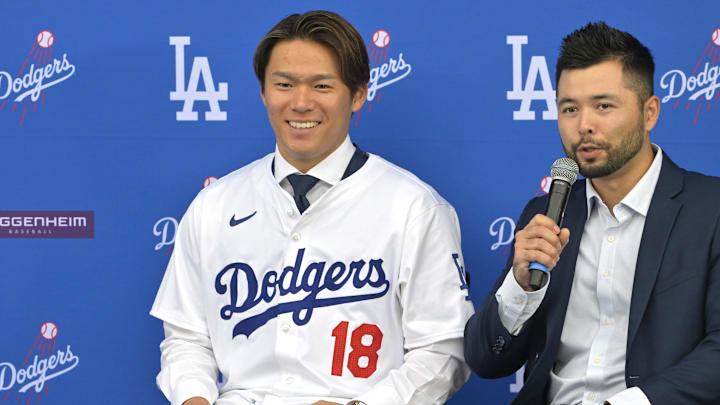Now that the Los Angeles Dodgers have agreed to pay Yoshinobu Yamamoto $325 million over a dozen seasons, the next pertinent question is this: What can the Dodgers reasonably expect to get for their money?
The process of projecting Yamamoto’s career path is challenging, but the end result boils down to two simple words: Who knows?
There are reasons – health, wear and tear -- why so few teams sign pitchers to mega-length deals. So while we can and will look at the data from recent case studies in an effort to develop a projection, that projection comes with daunting caveats. Let’s begin with the case studies, which should illuminate the caveats.
Over the past decade or thereabouts, a dozen pitchers have completed career arcs that roughly mirror what the Dodgers’ wallet envisions for Yamamoto. Those dozen were all rotation major league starters during their age-26 season, and they remained active a dozen years later, through their age 37 season. They become our comp group.
For the record, those dozen listed alphabetically are: Zack Greinke, Rich Hill, Ian Kennedy, Corey Kluber, John Lackey, Jon Lester, Charlie Morton, CC Sabathia, Anibal Sanchez, Max Scherzer, Justin Verlander and Adam Wainwright.
If you are a Yamamoto fan or a Dodger fan, your first reaction is probably elation. The dozen names listed above, by and large, constitute a distinguished group. Between their age 26 and age 37 seasons, these dozen pitchers ran up some impressive performance figures. The table below lists the average production of these dozen Yamamoto comps in six categories of significance.
Category Career avg. Season avg.
WAR 33.84 2.82
IP 1,851 154.1
Starts 293 24.4
Win Prob. Added 14.13 1.18
W-L 132-83 11-7
ERA 3.62 3.62
My guess is that anybody would sign on – even for a dozen seasons – to a pitcher who could guarantee 24 starts and 154 innings with a mid-threes ERA while producing an above-average, although not exceptional, WAR. Perhaps not at $27 million per year, but at some plausible price.
When you dig deeper into the data set of the 12 Yamamoto comps, though, the problem becomes reliability. How certain can you be that you’ll actually get that level of performance?
The uncertainty of the pitcher's life provides part of the answer. A scan of recent seasons for pitchers who were rotation starters at age 26 and who remained active through age 37 only turned up a dozen names. In recent years, about 150 starters have been used frequently enough in that role to be labeled as rotation regulars. Yet only that dozen – eight percent – lasted through their age 37 seasons.
The other part if the distressing answer lies in the standard deviation – that is, the normal performance range -- of those same dozen comps. For every Scherzer, Verlander or Greinke who Yamamoto might turn out to be, there’s also a Rich Hill, an Ian Kennedy or an Anibal Sanchez.
And in the cases of these dozen Yamamoto comps, the expected range of performance is, for lack of a better word, disquieting.
Begin with innings pitched, the basic workload number. Pitchers are paid for one thing: to pitch. If they don’t do that, they are worthless. While the average one-season workload of these dozen pitchers was 154.3 innings, the standard deviation amounted to a mammoth 41 innings.
In short, Yamamoto may produce 154 innings, but he may also produce 113, 195, or any number in between. All are equally likely. Take your chance.
The same is true of starts. The group average of 24.4 starts comes with a high standard deviation of 6.1. That means it is as likely that Yamamoto averages 18.3 starts, 30.5 starts or any number in between. There’s simply no telling.
ERA? The average might be 3.62 but the standard deviation is 0.44. That means all we can expect of Yamamoto is that he falls somewhere between an ERA of 3.18 – which would be exceptional – and 4.06, which would be exceptionally ordinary.
The Dodgers paid $325 million and they got a 12-season long gamble.
Obviously, in making that investment the, Dodgers believe Yamamoto produces closer to the Verlander-Scherzer end of the scale than the Kennedy-Sanchez end. If they do, they’ll win big. Between his age 26 and 37 seasons, Scherzer delivered a 3.01 ERA on an average of 29 starts and 188 innings of work. For Verlander, the stats were a 3.14 ERA in 30 starts encompassing just short of 200 innings, on average.
And that could happen. But injuries could also happen. Of our field of a dozen comps, Wainwright, Verlander, Morton, Kluber and Lackey each missed most or all of at least one season due to injury. Kennedy eventually saw his role diminished from starter to reliever, and Hill spent several seasons bouncing off and on major league rosters.
The bottom line is that a dozen seasons is a long time to count on predicable performance from a pitcher. The Dodgers have made that long term bet, and they could win with it. But a lot could also go wrong in a very costly way.
MLB Free Agency: What's Cody Bellinger worth? (calltothepen.com)
